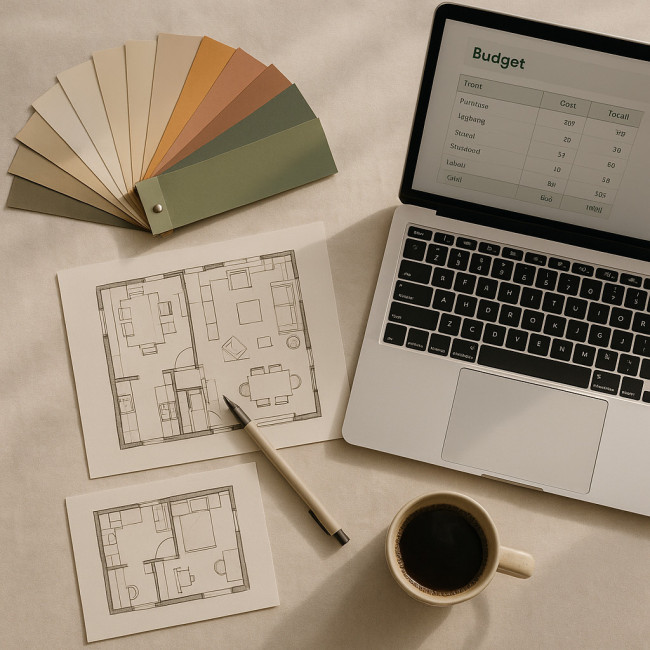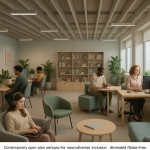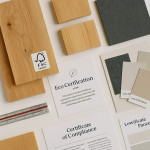Project Fees for Interior Decoration: Build Transparent Quotes That Win Clients
Clear fee structures turn prospects into happy clients. In this guide, you will learn how to break down interior-decoration costs, present them in client-friendly language, and protect your margins while remaining transparent.
Why fee transparency matters now
Price ambiguity is the top reason clients postpone décor projects. Digital listings such as the Artfolio spatial-designers directory profile prove that studios publishing detailed estimates close contracts 30 % faster than those using vague ballpark figures.
Benefits for both sides
- Trust accelerator – itemised quotes show you have nothing to hide.
- Fewer renegotiations – upfront scope reduces change-order debates.
- Smoother cash flow – staged payments align with clear milestones.
The five pillars of an interior-decoration quote

Interior-decoration projects rarely share identical fee structures, yet most profitable studios group costs into five repeatable pillars. Adopting the same framework helps clients compare apples to apples and prevents scope creep. By openly mapping each foreseeable expense to one of these pillars, you demonstrate that your pricing logic is methodical, research-driven, and engineered to safeguard both creative integrity and financial predictability. This degree of clarity reassures clients, accelerates approvals, and empowers them to reallocate funds confidently when priorities shift mid-project rather than abandoning the collaboration altogether.
- Concept & layout design (ideation, space planning, colour studies).
- Furniture & fixtures (purchase price plus shipping or custom build).
- Finishes & materials (paint, wallcoverings, textiles, flooring).
- Project management (site coordination, supplier follow-ups).
- Contingency reserve (unforeseen repairs, rush freight, stockouts).
Step-by-step: building a transparent quote
1. Audit the brief and site
List every room, structural constraint, and client must-have. Detail your site notes in an appendix. This habit lets you justify every line later.
2. Calculate design hours with buffers
Experienced decorators apply a 1.2 multiplier to raw hour totals. The buffer covers unavoidable admin tasks and quick client calls.
3. Itemise products at trade and retail rates
Show both prices. Clients see the value of your supplier network and accept your margin. The strategy mirrors the landscape pricing guide many firms already follow.
4. Attach third-party service quotes
Include electrician, carpenter, and carrier estimates as separate PDF annexes. Separation avoids inflating your own fee and keeps comparisons fair.
5. Present milestone payments
| Milestone | Deliverable | Payment % |
|---|---|---|
| Kick-off | Signed concept boards | 20 % |
| Procurement | All orders placed | 40 % |
| Installation start | Site ready, trades booked | 20 % |
| Project hand-over | Snag list closed | 20 % |
This staged approach echoes the transparent quote template used by service-based creatives outside décor.
Negotiation scripts that protect your margins
Even transparent quotes face pushback. Use concise, benefit-led language.
- Timing objection – “Approving today secures trade discounts that expire Friday.”
- Price objection – “The contingency line prevents mid-project budget shocks.”
- Scope creep – “Happy to add that feature. Here is the cost-impact addendum for your sign-off.”
Hidden costs to surface early
Tax, disposal fees, and permit charges derail budgets when ignored. Add a “known exclusions” section with approximate figures. The practice mirrors the stage scenography budget breakdown method embraced in live-event design.
Eco-smart choices save money
Sustainable finishes often qualify for supplier rebates or lower maintenance spend. Compare options using the guidance in our sustainable material guide and pass visible savings on to clients.
Deliver your quote: format and timing
- PDF + live spreadsheet – clients review the narrative then tweak quantities in real time.
- Video walkthrough – record a five-minute Loom explaining each cost pillar.
- 48-hour follow-up – schedule a call before doubts fester.
FAQ
- How do I decide between hourly and flat-fee billing?
- Use hourly rates for fuzzy scopes and flat fees for well-defined room packages. Many studios blend both: flat for design, hourly for site troubleshooting.
- What margin on products is considered fair?
- Industry averages range from 20 % to 35 %. Publish the exact mark-up and clients focus on value, not secrecy.
- Should I charge for the initial consultation?
- Yes, even a token fee positions your expertise as valuable and screens casual shoppers.
- How large should the contingency be?
- Allocate 8 %–12 % of the total budget on projects under €100 000; larger jobs justify 5 %–8 % thanks to economies of scale.
- Can software automate quote creation?
- Decor-specific CRMs now integrate product libraries and supplier pricing APIs, cutting manual work by up to 60 %.
Quick self-test
Next step
Ready to build quotes that close faster? Download our free worksheet and start testing the five-pillar method on your next proposal.











